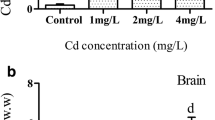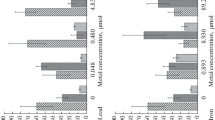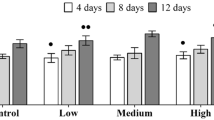Abstract
Manganese (Mn) is an essential metal for the development and function of the mammalian brain; however, excess Mn accumulation may cause neurological abnormalities resembling Parkinson’s disease due to reductions in brain dopamine levels. Because dopamine also regulates many functions in crustaceans, this study examined the effects of Mn accumulation in Dilocarcinus pagei, a Neotropical freshwater crab. Following a 72-h exposure to graded concentrations of MnCl2, Mn accumulation was assessed in several tissues. Glycaemia and the tyrosine hydroxylase (TH) immunostaining response were also examined as indicators of catecholaminergic function and catecholaminergic cell integrity, respectively. Tissue Mn accumulation was variable and occurred in the following order: gills > hepatopancreas > claw muscle > haemolymph. Exposure to 2 mM Mn reduced the gill levels of calcium, copper and iron, whereas Mn at all concentrations decreased zinc levels. All Mn-exposed animals showed lower copper levels in the hepatopancreas and haemolymph. Exposure to 2.0 mM Mn increased the haemolymph calcium. Mn exposure had no effect on glycaemia, whereas exposure to low Mn concentrations reduced the TH immunostaining response. Analysis of the central nervous system revealed the greatest Mn effect in the cerebral ganglion and the least effect in the abdominal ganglia. These results suggest the operation of an adaptive mechanism for tissue accumulation that could be responsible for the lack of an association between Mn concentrations and metal accumulation. The findings also suggest that Mn, calcium, iron and zinc share a transporter in gill cells and that Mn resistance is greater in the TH-positive cells of this crustacean than in mammalian cells.








Similar content being viewed by others
References
Ahearn GA, Mandal PK, Mandal A (2004) Mechanisms of heavy-metal sequestration and detoxification in crustaceans: a review. J Comp Physiol B 174:439–452
Alvarez RA, Villalobos MGP, Rosete GC, Sosa LR, Aréchiga H (2005) Dopaminergic modulation of neurosecretory cells in the crayfish. Cell Mol Neurobiol 25(2):345–370
Angeli S, Barhydt T, Jacobs R, Killilea DW, Ligthgow GJ, Andresen JK (2014) Manganese disturbs metal and protein homeostasis in Caenorhabditis elegans. Metallomics 6:1816–1823
Aschner M, Guilarte TR, Schneider JS, Zheng W (2007) Manganese: recent advances in understanding its transport and neurotoxicity. Toxicol Appl Pharmacol 221:131–147
Biagini G, Ferraguti F, Ponzoni S, Zoli M, Alboni L, Toffano G, Fuxe K, Agnati LF (1994) Neurochemical and behavioral studies on l-dopa toxicity in the model of manganese lesioned nigrostriatal pathway in the rat: evidence for a protective effect of the GM1 lactone siagoside. In: Fuxe K, Agnati LF, Bjelke B, Ohoson D (eds) Wenner-Gren symposium on trophic regulation of the basal ganglia: focus on dopamine neurons. Pergamon, Oxford, pp 381–407
Calvo AC, Pey AL, Miranda-Vizuete A, Døskeland AP, Martinez A (2011) Divergence in enzyme regulation between Caenorhabditis elegans and human tyrosine hydroxylase, the key enzyme in the synthesis of dopamine. Biochem J 434:133–141
Cellier M, Prive G, Belouchi A, Kwan T, Rodrigues V, Chia W, Gros P (1995) Nramp defines a family of membrane protein. Proc Natl Acad Sci USA 92:10089–10093
Chen P, Parmalee N, Aschner M (2014) Genetic factors and manganese-induced neurotoxicity. Front Genet 5:265. doi:10.3389/fgene.2014.00265
Chu NS, Hochberg FH, Caine DB, Olanow CW (1995) Neurotoxicity of manganese. In: Chang L, Dyyer R (eds) Handbook of neurotoxicology. New York, Marcel Dekker, pp 91–103
Corrêa JD Jr, da Silva MR, da Silva ACB, de Lima SM, Malm O, Allodi S (2005) Tissue distribution, subcellular localization and endocrine disruption patterns induced by Cr and Mn in the crab Ucides cordatus. Aquat Toxicol 72:139–154
Cotzias GC (1958) Manganese in health and disease. Physiol Rev 38:503–532
Culotta C, Yang M, Hall MD (2005) Manganese transport and trafficking: lessons learned from Saccharomyces cerevisiae. Eukaryot Cell 4(7):1159–1165
Donaldson J (1987) The physiopathologic significance of manganese in brain: its relation to schizophrenia and neurodegenerative disorders. Neurotoxicology 8:451–462
Dunkley PR, Bobrovskaya L, Graham ME, von Nagy-Felsobuki EL, Dickson PW (2004) Tyrosine hydroxylase phosphorylation: regulation and consequences. J Neurochem 91:1025–1043
Fanjul-Moles ML (2006) Biochemical and functional aspects of crustacean hyperglycemic hormone in decapod crustaceans: review and update. Comp Biochem Physiol C 142:390–400
Fingerman M, Kulkarni GK (1993) Quantitative measurement by reverse phase high performance liquid chromatography of norepinephrine in the central nervous system of the red swamp crayfish, Procambarus clarkii, and physiologically and pharmacologically induced alterations. Comp Biochem Physiol C 104:117–123
Garrick MD, Singleton ST, Vargas F, Kuo HC, Zhao L, Knopfel M et al (2006) DMT1: which metal does it transport? Biol Res 39:79–85
Goldstein M, Lieberman A (1992) The role of the regulatory enzymes of catecholamine synthesis in Parkinson’s disease. Neurology 42:8–12
Gorell JM, Johnson CC, Rybick BA, Peterson EL, Richardson RJ (1998) The risk of Parkinson’s disease with exposure to pesticides, farming, well water and rural living. Neurology 50:1346–1350
Granado e Sá M, Baptista BB, Farah LS, Leite VP, Zanotto FP (2010) Calcium sport and homeostasis in gills cells of a freshwater crab Dilocarcinus pagei. J Comp Physiol 180(3):313–321
Krang AS, Rosenqvist G (2006) Effects of manganese on chemically induced food search behaviour of the Norway lobster, Nephros norvegicus (L.). Aquat Toxicol 78:284–291
Kumar MVS, Desiraju T (1992) Effects of chronic manganese exposure on rat brain regional biogenic amines and GABA/glutamate system. Biog Amines 8:79–83
Lorenzon S, Edomi P, Giulianini PG, Mettulio R, Ferrero EA (2004) Variation of crustacean hyperglycemic hormone (CHH) level in the eyestalk and haemolymph of the shrimp Palaemon elegans following stress. J Exp Biol 207:4205–4213
Lüschen W, Willing A, Jaros PP (1993) The role of biogenic amines in the control of blood glucose levels in the decapod crustaceans, Carcinus maenas. Comp Biochem Physiol C 105:291–296
Martin K, Huggins T, King C, Carroll A, Catapane EJ (2008) The neurotoxic effects of manganese on the dopaminergic innervation of the gill of the bivalve mollusk, Crassotrea virginica. Comp Biochem Physiol C 148:152–159
Matsumoto K (1954) Neurosecretion in the thoracic ganglion of the crab, Eriocheir japonicus. Biol Bull 106:60–68
Maynard DM (1961) Thoracic neurosecretory structures in Brachyura. II. Secretory neurons. Gen Comp Endocrinol 1:237–263
Meco G, Bonifati V, Vanacore N, Fabrizio E (1994) Parkinsonism after chronic exposure to the fungicide maneb (manganese ethylene-bis-dithiocarbamate). Scand J Work Environ Health 20:301–305
Oweson C, Skold H, Pinsino A, Matranga V, Hernroth B (2008) Manganese effects on haematopoietic cells and circulating coelomocytes of Asterias rubens (Linnaeus). Aquat Toxicol 89:75–81
Parenti M, Flauto C, Parati E, Vescovi A, Groppetti A (1986) Manganese neurotoxicity effects on l-dopa and pargyline treatments. Brain Res 367:8–13
Ponzoni S (2012) Macrophages-mediated neurotoxic effects of intra-nigral manganese administration are attenuated by minocycline. Neurosci Lett 506:136–140
Ponzoni S (2014) Tyrosine hydroxylase protein expression in ventral nerve cord of Neotropical freshwater crab. Tissue Cell 46:482–489
Posser T, Franco JL, Bobrovskaya L, Leal RB, Dickson PW, Dunkley PR (2009) Manganese induces sustained Ser40 phosphorylation and activation of tyrosine hydroxylase in PC 12 cells. J Neurochem 110:848–856
Rainbow PS (1997) Ecophysiology of trace metal uptake in crustaceans. Estuar Coast Shelf Sci 44:169–175
Rodriguez EM, Medesani DA, Fingerman M (2007) Endocrine disruption in crustaceans due to pollutants: a review. Comp Biochem Physiol A 147:661–671
Sanders MJ, Du Preez HH, Van Vuren HJ (1998) The freshwater river crab, Potamonautes warreni, as a bioaccumulative indicator of iron and manganese in two aquatic systems. Ecotoxicol Environ Saf 41:203–214
Sarojini R, Nagabhushanam R, Fingerman M (1995) Dopaminergic and enkephalinergic involvement in the regulation of blood-glucose in the red swamp crayfish, Procambarus clarkii. Gen Comp Endocrinol 97:160–170
Smith EA, Newland P, Bestwick KG, Ahmed N (2013) Increased whole blood manganese concentrations observed in children with iron deficiency anemia. J Trace Elem Med Biol 27:65–69
Sura GR, Daubner SC, Fitzpatrick PF (2004) Effects of phosphorylation by protein kinase A on binding of catecholamines to the human tyrosine hydroxylase isoforms. J Neurochem 9:970–978
Takeda A, Sotogaku N, Oku N (2002) Manganese influences the levels of neurotransmitters in synapses in rat brain. Neuroscience 114(3):669–674
Tierney AJ, Kim T, Abrams R (2003) Dopamine in crayfish and other crustaceans. Distribution in the central nervous system and physiological functions. Microsc Res Tech 60:325–335
Tinikul Y, Mercier AJ, Sobhon P (2009) Distribution of dopamine and octopamine in the central nervous system and ovary during the ovarian maturation cycle in the giant freshwater prawn, Macrobrachium rosenbergii. Tissue Cell 41:430–442
Viarengo A (1989) Heavy metals in marine invertebrates: mechanisms of regulation and toxicity at the cellular level. Rev Aquat Sci 1:295–317
Wood DE, Derby CD (1996) Distribution of dopamine-like immunoreactivity suggests a role for dopamine in the courtship display behavior of the blue crab, Callinectes sapidus. Cell Tissue Res 285:321–330
Zhang D, Kanthasamy A, Anarharam V, Kanthasamy A (2011) Effects of manganese on tyrosine hydroxylase (TH) activity and TH-phosphorylation in a dopaminergic neural cell line. Toxicol Appl Pharmacol 254:65–71
Author information
Authors and Affiliations
Corresponding author
Ethics declarations
Conflict of interest
The author declares that they have no conflict of interest.
Rights and permissions
About this article
Cite this article
Ponzoni, S. Manganese tissue accumulation and tyrosine hydroxylase immunostaining response in the Neotropical freshwater crab, Dilocarcinus pagei, exposed to manganese. Invert Neurosci 17, 5 (2017). https://doi.org/10.1007/s10158-017-0198-7
Received:
Accepted:
Published:
DOI: https://doi.org/10.1007/s10158-017-0198-7




